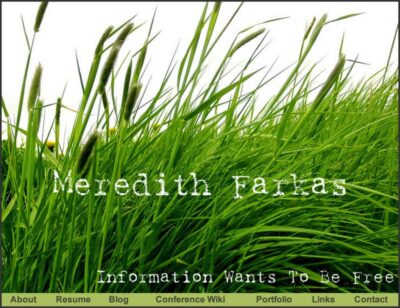This session was PACKED! I came in with Dave King and we both had to sit on the floor. There aren’t too many folks I’d sit on the floor for, but Roy Tennant and Andrew Pace are definitely two of them.
Roy and Andrew both took the word OPAC out of their presentaton, because it’s library-speak and is indicative of the thinking that led to our problems with library catalogs in the first place.
Roy spoke first.
What catalogs do well
- Inventory control
- Known-item searching
What they don’t do well
- any search beyond known item (subject)
- anything beyond books and journal titles
- displaying results in logical groupings
- faceted browsing
- relevance renking (how are things displayed?)
- recommendations (people who borrowed this book also borrowed…)
How did we get into this mess?
- automation began in the back room with circulation, cataloging and acquisitions. It was designed for librarians
- then they thought “hey, why can’t we stick this out in front of the public?” Patrons were an afterthought
- We continue to ask vendors for things that fill our needs but not our patrons’ needs
- We don’t use/reuse information well
Key problems
- we ignored discovery to focus on management of data
- we created stovepipe systems that don’t allow our systesms to communicate and share data
- we’ve abdicated responsibility for our systems
- we share materials, but not the responsibility for building/improving system
Assertions
- library catalog is only one finding tool. We can provide other information through databases and the Internet.
- The catalog should do what it’s good for. we don’t need to squish everything into the catalog
- users may not only be invested in what you have in your building (they may want consortial materials, ILL)
The future of the catalog
- one system among many that interoperate
- should function as part of a unified library finding tool
- refocused on local collections and interoperability with other tools
- will not be the most important finding tool
Signs of life:
- Report of the University of California Rethinking how we provide bibliographic services for the University of California
- Library of Congress study, The Changing Nature of the Catalog and its Integration With Other Discovery Tools
- PINES project
- Red Light Green
- OCLC’s Curiouser project
- CSU San Marcos X9 Books by David Walker
- NCSU’s Library Catalog
Catalogs for the Future – Andrew Pace
State of catalogs: We are overly obsessed with kw searching and authority searching.
Next gen searching/catalogs: Vivisimo, Endeca, AquaBrowser, ExLibris’ “Primo,” Innovative’s WebPAC Pro, Polaris, Talis, PINES, etc.
Andrew did a search with NCSU’s Catalog to show some of its features:
- Ability to refine search by subject, format, library
- can actually browse the entire catalog by leaving the search box blank
- can sort by circ status
- advanced searching
- browse search
- spell checking
- relevance ranking
- automatic stemming
- true LC browsing
- much more!
Endeca was behind the systems at Barnes and Noble and WalMart. They partnered with NCSU for mutual benefit. Endeca’s ProFind co-exists with their SirsiDynix Unicorn system. Endeca indexes MARC records exported from Unicorn and is refreshed daily while the system is up. MARC records are transformed into flat text files for the Endeca product, creating the opportunity to manipulate data on the back end.
The interface:
- started with lots of radio buttons and other options but then simplified it. Users can do refining post-search.
- brief view and a full-view option for viewing the results.
- 10 dimensions from MARC records
- using LCSH in new ways
- FRBR = “record rollup” outside of libraries
- creeping featuritis (realising they can’t do it all)
- most used dimensions: LC Classifications Subject, LC Classifications Topic
It’s great to have talks like this at conferences with diverse groups of librarians. There are many people who don’t know that our systems could be better and what we should be demanding from our vendors. It was also useful to show the positive examples — how catalogs are starting to improve and what we should demand in the future.
[tags]cil2006[/tags]



